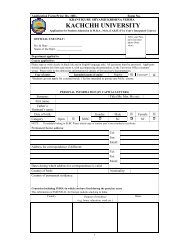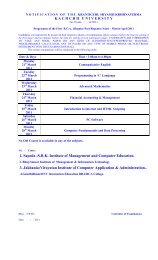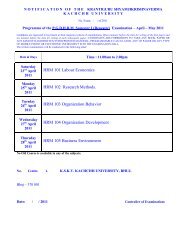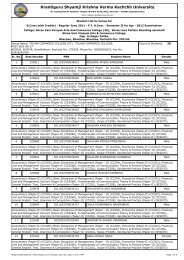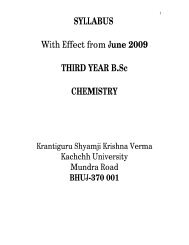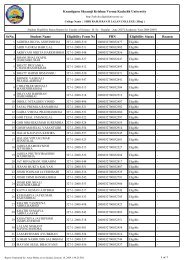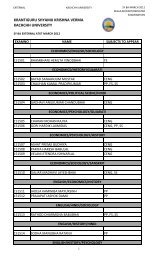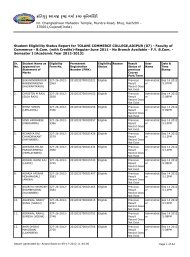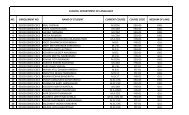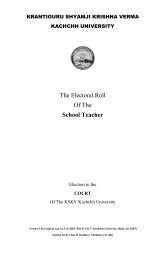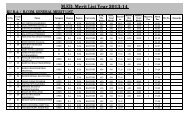F.Y B.A External - Kachchh University
F.Y B.A External - Kachchh University
F.Y B.A External - Kachchh University
You also want an ePaper? Increase the reach of your titles
YUMPU automatically turns print PDFs into web optimized ePapers that Google loves.
øÎ_Ï÷√applew U›Î‹∞ ¿ÚWHÎ ‰‹Î˝<br />
±ÎÀ˚˝Á Œı¿SÀÌ<br />
±ıŒ.‰Î›.⁄Ì.±ı.<br />
W.e.f. - 2008<br />
Only for <strong>External</strong><br />
— ’˛¿Î¿ —<br />
flÏ…VÀˇÎfl,<br />
¿ı.±ıÁ.¿ı.‰Ì. ¿E» ›appleÏfi‰ÏÁ˝ÀÌ, ¤Ò…<br />
‰Ê˝ — 2011
2<br />
K.S.K.V. KACHCHH UNIVERSITY
K.S.K.V. KACHCHH UNIVERSITY 3<br />
INDEX<br />
SR.NO. SUBJECT PAGE NO.<br />
1 ENGLISH 5 TO 10<br />
2 GUJARATI 11 TO 13<br />
3 HINDI 14 TO 17<br />
4 SANSKRIT 18 TO 21<br />
5 SINDHI 22 TO 24<br />
6 HISTORY 25 TO 28<br />
7 POLITICAL SCIENCE 29 TO 31<br />
8 PSYCHOLOGY 32 TO 40<br />
9 SOCIOLOGY 41 TO 48<br />
10 ECONOMICS 49 TO 55<br />
11 STATISTICS 56 TO 62<br />
GM\W GM\W o o DF+ DF+ V[18G V[18G V[18G˝, V[18G V[18G , lJnFYL lJnFYL˝VMG[ lJnFYL VMG[ OMD OMD OMD˝ OMD ;FY[ ;FY[ VF5JLP<br />
VF5JLP
4<br />
K.S.K.V. KACHCHH UNIVERSITY
K.S.K.V. KACHCHH UNIVERSITY 5<br />
KACHCHH UNIVERSITY<br />
LIST OF BOOKS PRESCRIBED AND SYLLABUS FOR EXAMINATION<br />
F.Y.B.A. SPECIAL, SUBSIDIARY AND FIRST SUBSIDIARY EXAMINATION<br />
K.S.K.V. KACHCHH UNIVERSITY<br />
Compulsory English<br />
F.Y.B.A / B.Com. / B.SC (Common Stream)<br />
(In Effect from June-2007)<br />
Text: “DEVELOPING ENGLISH SKILL”<br />
Ed.by P.K.Thaker, Desai, T.J.Purani OUP, 2006.<br />
UNIT : - I / II :<br />
(i) Objective type questions based on the Prescribed text. [10]<br />
(ii) Text based passage for comprehension. [10]<br />
UNIT : - III :<br />
(i) Paragraph Writing<br />
(A Short composition of not more than 150 Words on a given topic or sentence)<br />
(ii) Developing a Short dialogue on familiar Situations. (Two Options be given) [5]<br />
Note : Three internal options be given for paragraph writing.<br />
UNIT : - IV :<br />
Commercial Correspondence + Foreign words 15 Marks<br />
(Bank and Agency Correspondence, Application for Job)<br />
Foreign Words. 05 Marks<br />
UNIT : - V :<br />
Grammar and Vocabulary: 20 Marks<br />
(1) Concord<br />
(2) Connective devices<br />
(3) Figurative/ Literary Expression (Last will be Provided)<br />
(4) Idioms and Phrases Total 70 marks
6<br />
F.Y.B.A<br />
MAIN AND SUBSIDIARY ENGLISH<br />
2007 & until further noties<br />
Paper - 1 : Foundation studies in English<br />
K.S.K.V. KACHCHH UNIVERSITY<br />
1. Introduction to the History of English Literature:<br />
(a) General acquaintance with the ages of history of English Literature and their<br />
Characteristics. The candidates will be asked to enumerate the characteristic of a given<br />
period from 1550 to 1960. Their acquaintance will be tested by a objective nature,<br />
asking them to relate characteristics to the period.<br />
The Following period are prescribed:<br />
1559-1625, 1625-1660, 1660-1700, 1701-1740,1740-1798, 1798-1832,1832-1890,<br />
1890-1918, 1918-1939, 1939-1960<br />
5 Marks<br />
(b) Candidates will be asked to relate the following writes to their respective ages : Spencer,<br />
Marlowe, Shakespeare, Philip Sidney, Lyly, Kyd, Ben Jonson, Francis Bacon, John<br />
Webster, John Bunyan, Milton, Donne, Dryden, Congreve, Swift, Addison, Steele, Pope,<br />
Richardson, Fielding, Dr. Johnson, Gibbon, Goldsmith, Sheridan, Jane Austen, Sir<br />
Walter Scott, Wordsworth, Coleridge, Shelly Byron, keats, Charles Lamb, Hazlitt, De<br />
Quincey, Tennyson, Browing Arnold, Ruskin Carlyle, Dickens, Thackeray, Emily Bronte,<br />
Charlotte Bronte, George Eliot, Thomas Hardy, Joseph Conrad, H.G. Wells, Arnold<br />
Bennet, G.B.Shaw, Galsworthy, Virginia woolf, james joyce, T.S.Eliot, W.H. Auden,<br />
D.H.Lawrence, W.B.Yeats, Somerset Mauugham.<br />
5 Marks<br />
(c) Candidates will be asked to relate the following writers to their works. 8 Marks<br />
Writers Works<br />
1. Shakespear Hamlet, Macbeth, Othello, King lear As You Like It,<br />
A midsummer Night’s Dream.<br />
2. Geofferey Chaucer the Canterbury Tales.<br />
3. Marlowe Dr. Faustus<br />
4. Ben Jonson Everyman in his Humour<br />
5. Edmud Spencer the Faerie Queene<br />
6. Philip Sidney Arcadia<br />
7. Francis Bacon the Essays the Eassys<br />
8. John Milton Paradise Lost<br />
9. Dryden Absalom and Achitophel<br />
10. Congreve The way of the world<br />
11. Jonathan Swift Gulliver’s Travels<br />
12. Addison and steele Coverly Papers<br />
13. Alexander Pope the Rape of the Lock<br />
14. Dr.Johnson London<br />
15. Richardson Pamela
K.S.K.V. KACHCHH UNIVERSITY 7<br />
16. Fielding Tom Jones<br />
17. Sterne Sentimental Journey<br />
18. Oliver Goldsmith Vicarof Wakefield,she Stoops of Conquer<br />
19. Sheridan The School for scandal<br />
20. Gray Elegy Written in the country Churchyard<br />
21. Wordsworth & Coleridge Lyrical Ballads<br />
22. Willim wordsworth Tintern Abbey<br />
23. Coleridge Biographia Literaria<br />
24. P.B.Shelley Adonais<br />
25. John Keats Eve of St.Agnes<br />
26. Byron Childe Harold<br />
27. Jane Austerm Pride and Prejudice,Emma<br />
28. Sir Walter Scott Ivanhoe<br />
29. Charles Lamb Essays of Elia<br />
30. Lord Tennyson In Memoriam<br />
31. Robert Browning Dramatic Monologues<br />
32. Mathew Arnold Sohrab and Rustum<br />
33. Charles Dickens David Copperfield<br />
34. Thackeray Vanity Fair<br />
35. John Ruskin Unto this Last<br />
36. Cyrlyle Past and Present<br />
37. George Eliot Silas Mariner<br />
38. Oskar Wilde Importance of Being Ernnest<br />
39. G.B.Shaw Candida,Arms and the man<br />
40. John Galsworthy Forsyte Saga<br />
41. John Masfield Salt Water Ballads<br />
42. Thomas Hardy Tress of the D’urbervilles<br />
43. Virginia Joyce To the Lighthouse<br />
44. James Joyce Ulysses<br />
45. Robert Brinnett Testament of Beauty<br />
46. Arnold Bennett The Old Wuve’s Tale<br />
47. D.H.Lawrence Sons and Lovers<br />
48. W.S.Maugham Of Human Bondage<br />
49. E.M. Foster A Passageof India<br />
50. Aldous Huxley Brave New World<br />
51. Joshep Conrad Lord Jim<br />
52. J.M.Synge Riders to the Sea<br />
53. W.B.Yeats The Countess Cathleen<br />
54. T.S.Eliot The Waste Land<br />
55. J.M.Barrie The Admirable Crichton<br />
56. W.H.Auden and The Autumn Journal<br />
Christopher Isherwood<br />
57. Louis Macniece The Autumn Journal<br />
58. Steohen Scoender Outline of History<br />
59. H.G.Wells Destructive Element<br />
60. A.J.Toynbee A Study Of History
8<br />
K.S.K.V. KACHCHH UNIVERSITY<br />
2. (a) Definition and General Characteristics of literature 14 Marks<br />
(b) Function of literature and the reason of studying literature<br />
(c) Elementary acquaintance with the following terms. 08 Marks<br />
(Candidates will be asked to write on four terms in four to five Sentences)<br />
Plot, Character, Theme, Setting, Dialogue, Diction, Jangon, Dialect, Wit, Humour, Irony,<br />
Rhythm, metre, Confict, Suspense, Episode, Climax, Antihero, Protagonist, Antagonist,<br />
Denouement,Classtrophe, Chorus, Poetic Justice, catharsis, Symbol, Legend, Allegory,<br />
myth, Divine ‘Machinery’, Allusion, Pastoral, Heroic.<br />
3. Two Text Books:<br />
Text 1: Fiction Drama.<br />
Text 2 : Poems with one/two theme(s)<br />
Prescribed Text Books:<br />
Text 1: George Orwell<br />
15 Marks<br />
Text 2 : Panorama, A Selection of Poems (Revised Edition) (OUP) 15 Marks<br />
List of Poems:<br />
1. William Wordsworth - To a skylark.<br />
2. John Keats - Ode to a Nightingale<br />
3. William Blake - The Tiger<br />
4. Christina Rossetti - Uphill<br />
5. John Milton - On his Blindness<br />
6. Robert Frost - Stopping by woods on snowy Evening<br />
7. John Donne - The Sun Rising<br />
8. Lord Byron - She Walks in Beauty<br />
Books Recommended:<br />
1. Introduction to the study of Literature - W.H. Husdon<br />
2. Outline History of English Literature - W.H. Husdon<br />
3. English Literature - Antony Burgess<br />
4. A Short History Literature - E.E. Albert<br />
5. Indo-English Literature - M.K.Naik<br />
6. Dictionary of Literary-terms Martin Gray,<br />
(York Handbooks Longmans, York Press)<br />
7. Oxford Companion to English Literature
K.S.K.V. KACHCHH UNIVERSITY 9<br />
Paper - II<br />
Literature in English Language<br />
This paper will consist of 5 units.Each unit will comprise of one long text<br />
(novel of full length play) or a number of shorter text (Short stories, one-acts)<br />
1. Khushwant Singh : A train to Pakistan<br />
2. Shakespeare : The Merchant of Venice<br />
3. Tagore : The post office<br />
4. “Eight short stories” : ed. By K.N.Vasudeva Panikar<br />
5.<br />
(Orient Longman lost 4 short Stories only)<br />
“One-act Plays for colleges.Ed. V.A.Sahane (OUP) (Play No.1 & 4 Only)”<br />
Recommended Books:<br />
1. B.Prashad : A Background to the study of English Literature (Macmillin)<br />
2. R.J.Rees : English Literature : An Introduction for Foreign Readers (Macmillan)<br />
3. Upham.A.H : The Typical forms of English Lirerature
10<br />
F.Y.B.A<br />
ENGLISH SECOND SUBSIDIARY : PAPER - 7<br />
K.S.K.V. KACHCHH UNIVERSITY<br />
Only the students of “A” Stream will be allowed to study this paper.<br />
Objective : The two year course is instended to equip the student with skill which will enable<br />
him to comprehend the language with a reasonable degree of accuracy in its<br />
spoken and written forms.<br />
1. (a) Use of Dictionary: With abbreviation used 10 Marks<br />
(b) Expression of future, purpose, ability, permission, Possibility, obligation and<br />
Condition.<br />
2. Rapid Reading: An abridged and simplified text will be prescribed<br />
Text: The Best of Guy De<br />
30 Marks<br />
3. Comprehension: A Prose passage of about 300 words will be set Question<br />
of factual and inertial nature will be asked.<br />
10 Marks<br />
4. Composition: Writing Letters, Personal Letters and letter written socially to<br />
regret, of condolence etc. will be asked<br />
10 marks<br />
5. Translation from English sentences of a small passage of about a hundred<br />
words in Gujarati or Hindi<br />
10 Marks
K.S.K.V. KACHCHH UNIVERSITY 11<br />
S[PV[;PS[PJLP S[PV[;PS[PJLP SrK SrK I]lGJl; I]lGJl;˝8L I]lGJl; 8L<br />
I]PÒP;L I]PÒP;L DM0, DM0, DM0, VF3FlZT<br />
VF3FlZT<br />
sZ__*v_( sZ__*v_( GL GL 5ZLÙFVM 5ZLÙFVM 5ZLÙFVM DF8[ DF8[ lGWF lGWF lGWF˝lZT lGWF lZT 5F9I 5F9I S|D S|D f<br />
f<br />
lJQFIo lJQFIo U]HZFTL<br />
U]HZFTL<br />
5|YD 5|YD 5|YD JØ JØ˝ JØ ALPV[P<br />
ALPV[P<br />
sD]bI sD]bI sD]bI VG[ VG[ 5|YD 5|YD UF{6f<br />
UF{6f<br />
5| 5|fG5+o 5| G5+o ! ! 5nGF[ 5nGF[ VeIF;<br />
VeIF;<br />
!P AÚCN U]HZFTL SFjI 5lZRI B\0v!<br />
v GZl;\CGF 5N YL VFZ\EFTF TDFD DwISF,LG 5NF[<br />
;\5FNG o DF[CGEF. 58[, RgN=SFgT X[9<br />
U]HZFT lJnF5L9v VDNFJFN<br />
ZP 5JGGF J[XDF\v WLZ[gN= DC[TF slGIT SÚlTVF[ f VFZPVFZP VDNFJFN<br />
lGIT SÚlT S|DF\S o !4#4!#4 !(4Z# 4Z54 #$4 $Z 4 $&4 5& 45(4*Z4 *(4 5)4 &54 *!4<br />
(_4 ($4 (&4 )!4 )$4 )&4 )*4 !_Z4 !_$ 4!!_4 !!Z4 !!#4 !!&<br />
V[SDov! lJlJW SFjI:J~5F[GL ;DH s B\0SFjI4 ULT4 Uh,4 ;F[G[8 f<br />
V[SDovZ DwISF,LG SÚlT lJØ[ Z;,1FL 5|fG<br />
V[SDov# DwISF,LG SÚlTVF[ lJX[ 8}\S GF[\W VG[ VJFRLG SÚlT lJX[GL 8}\S GF[\W<br />
V[SDov$ VJFRLG SÚlT lJX[ Z;,1FL 5|fG<br />
V[SDov5 GLR[ D]HAGF K\N v V,\SFZ o s:J~5GL ;DH VG[ pNFCZ6G[ VFWFZ[ VM/B f<br />
K\N o lXBlZ6L4 D\NFS|FgTF45ÚyJL XFN}, lJS|Ll0T4 RF[5F.4 NF[CZF[<br />
V,\SFZ o ~5S4p5DF 4pt5|[1FF4f,[Ø4 J6FG]5|F;4 ;ÒJFZM56<br />
GM\W o 5}JF5Z ;\NE˝G[ ,UTF 5|fGF[ 5}KJF GCL\P<br />
;\NE ;\NE˝ ;\NE U|\Y U|\Y o<br />
o<br />
!P ;FlCtIGM :JFwIFI 5}JF˝W˝ o lJPDPEõ<br />
ZP SlJTFGL ;DH o C[D\T N[;F®<br />
#P XaNGL XlST o pDFX\SZ HMXL<br />
$P pNU|LJ o lJGMN HMXL<br />
5P U]HZFTL ;FlCtI sDwISF,LGf o VG\TZFI ZFJ,<br />
&P DwISF,LG U]HZFTL ;FlCtIGM .lTCF; o 0FP ZD[X l+J[NL<br />
*P 5L\U/ NX˝G o lRDGEF. l+J[NL<br />
(P K\N VG[ V,\SFZ o N1F[X 9FSZ
12<br />
!P VMTZFTL NLJF,M<br />
v SFSF;FC[A SF,[,SZ4 GJÒJG4 VDNFJFN<br />
ZP W}/DF\GL 5U,LVM<br />
v RgN=SFgT X[94 VFZPVFZPX[94 VDNFJFN<br />
5|Æ5+ 5|Æ5+ o o Z<br />
Z<br />
UnGM UnGM VeIF;<br />
VeIF;<br />
V[SD o! sSf VFtDSYFGFtDS ;FlCtI :J~5MGL ;DH s VFtDSYF v ;\:DZ6M f<br />
sBf VFtDSYFGFtDS ;FlCtI :J~5MGM pNŸEJ v lJSF;GM 5lZRIFtDS<br />
VF,[B<br />
sVFtDSYF v ;\:DZ6M f<br />
V[SD oZ 5|YD S°lT lJØ[ ;FDFgI 5|ÆM<br />
V[SD o# läTLI S°lT lJØ[ ;FDFgI 5|ÆM<br />
V[SD o$ 5|YD VG[ läTLI S°lT lJØ[ 8}\SGM\WM<br />
V[SD o5 GLR[GF D]NŸFVMGL ;FDFgI ;DH<br />
lJZFDlRgCMŸ4 JFSIlJRFZ4 JFSI 5|SFZ4 JFSI 5lZJT˝G<br />
5}JF˝5Z ;\NE˝G[ ,UTF 5|`GM 5}KJF GCL\<br />
;\NE ;\NE ;\NE˝ ;\NE U|\Y U|\Y o<br />
o<br />
!P SF,[,SZ VwIIG U|\Y o ;\PpDFX\SZ HMXL VG[ VgI<br />
ZP ;FlCtIGM :JFwIFI v 5}JF˝W˝ o lJPDPEõ<br />
#P VFtDSYF o ;TLX jIF;4 R\ÿˇDF{l,4 VDNFJFN<br />
$P AFZ ;FlCtI :J~5M o 5|;FN A|ïE|45F`J˝ VDNFJFN<br />
5P :J~5 ;lgGWFG o ;\P ;]DG XFC4 5F`J˝ VDNFJFN<br />
K.S.K.V. KACHCHH UNIVERSITY
K.S.K.V. KACHCHH UNIVERSITY 13<br />
V[SD o! VZÒ ,[BG o DF/B]\4 lJØIM4 EFØFP<br />
V[SD oZ VC[JF, o :J~54 lJØIM4 EFØFP<br />
V[SD o# ;\1F[5 o SN DIF˝NF45wWlTP<br />
5|Æ5+ 5|Æ5+ o o *<br />
*<br />
,[BG ,[BG SF{X, SF{X,<br />
SF{X,<br />
V[SD o$ VY˝lJ:TFZ o 5n VG[ Un4 :J~5 VG[ 5wWlTP<br />
V[SD o5 SC[JT v ~l-5|IMU<br />
SC[JT VG[ ~l-5|IMU JrR[GM E[N4 T[G]\ SFI˝ VG[ ¹Q8F\TMP<br />
GF[\W o NZ[S V[SDDF\ ;{wWF\lTS 5|`G VG[ T[GF GD}GFG[ ,UTF 5|`GGL V5[1FF K[P<br />
;\NE ;\NE˝ ;\NE U|\Y U|\Y o<br />
o<br />
!P 5+4 VZÒ VG[ VC[JF, ,[BG o ZlT,F, GFIS<br />
ZP EFØF ;HHTF VG[ ,[BG SF{X, o 0FP IF[U[gN= jIF;<br />
#P VZÒ VG[ ,[BG SF{X, o 5|;FN A|ïEÎ<br />
$P SC[JTM4 ~l-5|IMU VG[ SC[JT SMX o R\lN=SFA[G 58[,<br />
5P U]HZFTL EFØF 5lZRI o EFØF lGIFDSGL SR[ZL<br />
U]PZFPUF\WLGUZ
14<br />
K.S.K.V. KACHCHH UNIVERSITY<br />
SrK SrK I]lGJl; I]lGJl;¸8L I]lGJl; 8L 8L<br />
I}HL;L I}HL;L DF0, DF0, DF0, VFWFlZT<br />
VFWFlZT<br />
lJQFI lJQFI o o lCgNL<br />
lCgNL<br />
5|YD 5|YD JQF JQF¸ JQF v v ALP ALP ˆP<br />
ˆP<br />
5|`G5+v! 5|`G5+v! o o VFW]lGS VFW]lGS lCgNL lCgNL lCgNL SlJTF SlJTF sD]bI sD]bI ˆJ\ ˆJ\ UF{6 UF{6 lJQFI lJQFI S[ S[ lJnFlY lJnFlY¸IM\ lJnFlY IM\ S[ S[ l,ˆf<br />
l,ˆf<br />
!P !P VFW]lGS VFW]lGS lCgNL lCgNL SlJTF SlJTF o o<br />
o<br />
;\5FNS ;\5FNS<br />
o 0FP VF,MS U]ÃT v 5|YD ;\:SZ6v!))$ 5F`J¸ 5|SFXGvVCDNFAFN<br />
!P lNGSZ o VG, v lSZL8<br />
@P ClZJ\XZFI ArRG o ;FYL ;[4 lSTGF VS[,F VFH D{\<br />
#P S[NFZGFY VU|JF, o GL,[ 5\BM\ JF,L lRl0IF4 5{TÎS ;d5lT<br />
$P GFUFH]¸G o pGSM 5|6FD ¦4 DG SZTF C{\<br />
%P l+,MRG o Rd5F SF,[ SF,[ VrKZ GCL\ RLgCTL SM.¸ lNG YF HAlS<br />
&P V7[I o GNL S[ £L5<br />
*P XDX[Z ACFN]Z l;\C o pQFF<br />
CDSM EL AC]T S]K IFN YF<br />
(P D]lÉTAMW o D{\ T]D ,MUM\ ;[ N}Z C}Å<br />
)P ;J[¸XJZNIF, ;É;[GF o A]lwWHLJL4 ,F, ;FIlS,<br />
!_P WD¸JLZ EFZTL o 8}8F 5lCIF<br />
!!P ZFDNZXF lDz o NJF SL T,FXF4 ZFHWFGL ˆÉ;5|[;<br />
!@P Z3]JLZ ;CFI o ZFDNF;<br />
!#P zLSFgT JDF¸ o 5|[D v JÉTjI<br />
!$P S[NFZGFY l;\C o HLG[ S[ l,ˆ S]K XFT[¸4 p; VFNDL SM N[BM<br />
!%P N]QI\gT S]DFZ o SCFÅ TM TI YF<br />
@P @P @P IXMWZF IXMWZF<br />
v D{lY,LXZ6 D{lY,LXZ6 U]ÃT<br />
U]ÃT<br />
v ;\5FNS o ;FlCtI ;{NG4 lRZUFÅJ4 hFÅ;L š
K.S.K.V. KACHCHH UNIVERSITY 15<br />
!P KFIFJFN o GFDJZl;\C<br />
;\NE ;\NE¸ ;\NE U|\Y U|\Y <br />
@P DCFN[JL o .gãGFY DNFG<br />
#P lGZF,F o ZFDlJ,F; XDF¸<br />
$P ;]lDUFGgNG 5\T o 0FP GU[gã<br />
%P HIX\SZ 5|;FN o G\NN],FZ[ AFH5[IL<br />
&P D{lY,LXZ6 U]ÃT<br />
jIlÉT…J ˆJ\ S]lT…J o NFG AFUN}Z 5F9S4 lJGMN 5]:TS D\lNZ4 VFUZF š<br />
V\S V\S lJEFHG lJEFHG <br />
# jIFbIFˆÅ # 2 * = @!<br />
@ VF,MRGFtDS 5|`G @ 2 !! = @@<br />
@ ;\l1FÃT 5|`G @ 2 & = !@<br />
!% ;\l1FÃT ˆJ\ J:T]lGQ9 5|`G !% 2 ! = !%<br />
S], V\S = *_ *_<br />
*_
16<br />
K.S.K.V. KACHCHH UNIVERSITY<br />
5|YD 5|YD JQF JQF¸ JQF v v ALPˆP<br />
ALPˆP<br />
5|`G5+v@ 5|`G5+v@ o o lCgNL lCgNL SYF SYF SYF ;FlCtI ;FlCtI sD]bI sD]bI ˆJ\ ˆJ\ UF{6 UF{6 lJQFI lJQFI lJQFI S[ S[ lJnFlY lJnFlY lJnFlY¸IM\ lJnFlY IM\ S[ S[ S[ l,ˆf<br />
l,ˆf<br />
!P VF5SF A\8L o DgG} E^0FZL4 5|P ZFWFSÎQ6 5|SFXG4 G.¸ lN
K.S.K.V. KACHCHH UNIVERSITY 17<br />
5|YD 5|YD JQF JQF"""" JQF JQF"<br />
v v ALPˆP<br />
ALPˆP<br />
l£TLI l£TLI UF{6<br />
UF{6<br />
5|`G5+v* 5|`G5+v* o o ;FDFgI ;FDFgI lCgNL lCgNL<br />
lCgNL<br />
z[Q9 z[Q9 SCFlGIFÅ SCFlGIFÅ o o ;\ 0FP VJWGFZFI6 l+5F9L<br />
0FP VZlJgN HMXL<br />
0FP E|DZ,F, HMXL<br />
;\ 5F`J¸ 5|SFXG4 VCDNFAFN<br />
lGdGl,lBT SCFlGIFÅ 5F9ŸIS|D D[\ ;DFlCT C{\ ov<br />
!P A0[ EF.¸ ;FCA v 5|[DRgN<br />
@P 5]Z:SFZ v 5|;FN<br />
#P JLZ AFN, v RT]Z;[G XF:+L<br />
$P VSAZL ,M8F v AFA} VgG5}6F¸<br />
%P B}G SF lZXTF v ELQD ;FCGL<br />
&P VFtDlX1F6 v H{G[gã<br />
*P R]GFJ v ZFH[gã IFNJ<br />
V\S V\S lJEFHG lJEFHG <br />
@ VF,MRGFtDS 5|`G @ 2 !@ = @$<br />
@ ;\l1FÃT 5|`G @ 2 & = !@<br />
! U]HZFTL VYJF V\U|[HL S[ VG]JFN ! 2 !_ = !_<br />
$ E}, ;]WFZ $ 2 ! = _$<br />
% D]CFJZ[\vSCFJT[\ s5F9ŸI 5]:TS ;[f % 2 ! = _%<br />
!% J:T]lGQ9F 5|`G !% 2 ! = !%<br />
S], S], V\S V\S<br />
= *_<br />
*_
18<br />
S|F\lTU]Z] S|F\lTU]Z] xIFDÒ xIFDÒ S°Q6JDF S°Q6JDF˝ S°Q6JDF<br />
SrK SrK I]lGJl; I]lGJl;˝8L I]lGJl; 8L<br />
5|YD 5|YD JØ JØ˝ JØ ALPV[P<br />
ALPV[P<br />
;\:S°T ;\:S°T v v OZÒIFT<br />
OZÒIFT<br />
5\RZF+DŸ 5\RZF+DŸ 5\RZF+DŸ v v v Z3]J\XDŸ Z3]J\XDŸ Z3]J\XDŸ ;U ;U˝vZ ;U vZ 4 4 V5l9T V5l9T `,MSM<br />
`,MSM<br />
V[SDv! V[SDv!<br />
V[SDvZ<br />
V[SDvZ<br />
5\RZF+DŸ 5\RZF+DŸ<br />
VG]JFN VG[ ;\NE˝ S°lTGF[ VF:JFN<br />
K.S.K.V. KACHCHH UNIVERSITY<br />
V[SDv# V[SDv# V[SDv#<br />
V[SDv$ V[SDv$<br />
V[SDv$<br />
Z3]J\XDŸ Z3]J\XDŸ<br />
;U˝vZ VG]JFN ;FY[ ;DH}lT ;U˝vZ S°lTGF[ VF:JFN<br />
V[SDv5sVf V[SDv5sVf<br />
V[SDv5 V[SDv5 sAf<br />
sAf<br />
EF;4SFl,NF;GF\ ÒJG4<br />
;DI4SJG<br />
V5l9T ;\:S°TDF\YL VG]JFN
K.S.K.V. KACHCHH UNIVERSITY 19<br />
S|F\lTU]Z] S|F\lTU]Z] S|F\lTU]Z] xIFDÒ xIFDÒ S°Q6JDF S°Q6JDF˝ S°Q6JDF<br />
SrK SrK I]lGJl; I]lGJl;˝8L I]lGJl; 8L<br />
5|YD 5|YD JØ JØ˝ JØ ALPV[<br />
ALPV[<br />
;\:S°T ;\:S°T v v 5[5Z 5[5Z G\P!<br />
G\P!<br />
D]bI D]bI VG[ VG[ 5|YD 5|YD UF{6<br />
UF{6<br />
VFQF VFQF˝SFjI VFQF SFjI<br />
;]\NZSF^0 ;]\NZSF^0 slGITF\Xf4 slGITF\Xf4 EFQFFG{5]^I<br />
EFQFFG{5]^I<br />
V[SDv! V[SDv!<br />
V[SDvZ<br />
V[SDvZ<br />
ZFDFI6 VG]JFN ;FY[ ;DH}lT s5 DF\YL #f<br />
;FlCtI :J~54;DL1FF4;\:SZ64ZRGFSF, ;U˝v!_4!#4!(4Z!4Z&4<br />
VFI˝ DCFSFjI jIFbIF4<br />
;\:S°T ;FlCtI 5Z 5|EFJ<br />
#)4#(<br />
V[SDv# V[SDv# V[SDv#<br />
V[SDv$<br />
V[SDv$<br />
VG]JFN ;FY[ ;DH}lT s5 DF\YL #f 5|`GF[¿Z4 ;]\NZSF^0<br />
;U˝v$&4$(4$)45_45! S°lTGF[ VF:JFN<br />
V[SDv5sVf V[SDv5sVf<br />
V[SDv V[SDv 5sAf 5sAf<br />
5sAf<br />
lJJ[RGFtDS GM\W sA[ DF\YL V[Sf jIFSZ6v~5 VM/BFJM<br />
;]\NZSF^0 sJFSIDF\ 5|IMU V5[l1FT GYLf<br />
sVSFZFgT VG[ .SFZFgT:+LP4<br />
5|YDU6GF JT˝DFGSF/4<br />
ìF:TG E}TSF/ VG[ 5ZM1F<br />
E}TSF/GF\ ~5MPf
20<br />
S|F\lTU]Z] S|F\lTU]Z] xIFDÒ xIFDÒ S°Q6JDF S°Q6JDF˝ S°Q6JDF<br />
SrK SrK I]lGJl; I]lGJl;˝8L I]lGJl; 8L<br />
5|YD 5|YD JØ JØ˝ JØ ALPV[P<br />
ALPV[P<br />
;\:S°T ;\:S°T v v 5[5Z 5[5Z G\PZ<br />
G\PZ<br />
D]bI D]bI D]bI VG[ VG[ 5|YD 5|YD UF{6<br />
UF{6<br />
;\:S ;\:SÚT ;\:S T ;FlCtIGF[ ;FlCtIGF[ .lTCF;<br />
.lTCF;<br />
VP SFNdAZL sDCF`J[TF J°¿FgTf<br />
sULTFJ;FG[ D}SL E}TJL6FPPPPPPYL lGo:5gNDlTQ9D˝f<br />
AP ;\:SÚT ;FlCtIGF[ .lTCF;P<br />
SP KgN<br />
V[SD o ! DCF`J[TFJ°¿FgT VG]JFN VG[ ;\NE˝P<br />
V[SD o Z DCF`J[TFJ°¿FgT VF:JFN VG[ SlJ 5lZRIP<br />
V[SD o # DCFSFjI4 GF8S VG[ UnSYFGF\ pt5l¿4 lJSF; VG[ ,1F6M<br />
K.S.K.V. KACHCHH UNIVERSITY<br />
V[SD o $ GLR[GF STF˝VF[GF\ ÒJG4 ;DI4 SÚlT5lZRI4 SÚlTD}
K.S.K.V. KACHCHH UNIVERSITY 21<br />
VP VlE7FGXFS]gT,D˚ v V[S VwIIG<br />
AP 5|F:TFlJSlJ,F; slGITF\Xf s! YL 5_ `,MSfP<br />
V[SD o ! SFl,NF;v ÒJG v SJG VG[ ;DI<br />
V[SD o Z V\SJFZ 5lZRI<br />
V[SD o # ;FlCltIS D}
22<br />
K.S.K.V. KACHCHH UNIVERSITY<br />
F.Y.B.A.- SINDHI<br />
MAIN & FIRST SUBSIDIARY<br />
“SINDHI POETRY”- Paper – 1<br />
BOOK ONE : Pal Pal jo parlau<br />
- Hari Daryani ‘Dilgir’<br />
(Published By Sindhi Academy,delhi.year : 2000)<br />
Vaayoon - Page 10 to 17<br />
Nazmoon - Page 18 to 52<br />
Nazmano Nasur - Page 87 to 90<br />
BOOK TWO : Dharti –a jo Dardu<br />
- Arjun ‘shad’<br />
(Published By Sindhi Academy,delhi.year : 1999)<br />
Poem - page 7 to 47<br />
Division of Marks for <strong>University</strong> Examination :<br />
2 Long question 2×12= 24<br />
3 References 3×7= 21<br />
2 Short Notes 2×5 = 10<br />
5 Fill in the blanks 5×1 = 05<br />
2 Complete the stanza 2×3 = 06<br />
1 Intro.of Poet 1×4 = 04<br />
Total Marks 70<br />
K.S.K.V. KACHCHH UNIVERSITY
K.S.K.V. KACHCHH UNIVERSITY 23<br />
BOOK ONE : Choond sindhi Kahaniyoon -2<br />
K.S.K.V.<br />
KACHCHH UNIVERSITY<br />
F.Y.B.A.- SINDHI<br />
MAIN & FIRST SUBSIDIARY<br />
“SINDHI PROSE”- Paper – 2<br />
(Published By Sahitya Academi)<br />
(Ten Stories – Mohammad Gadi – a varo,Robu,Murk ain Mamta,Daag,Chunnu ain Munni,Mitha<br />
khattasangtara,Yaadgiriyun,DastavezuMaan ruano aahiyan,Na maran jo dukh)<br />
BOOK TWO : Functional Sindhi (Part 1)<br />
By Dr.S.G. Dharmani and Vimmi Sadarangani<br />
Divison of Marks for <strong>University</strong> Examination :<br />
2 Long question 2×12 = 24<br />
2 References 2×5 = 10<br />
2 Short Notes 2×5 = 10<br />
6 Fill in the blanks 6×1 = 06<br />
Objective Type:<br />
Functional Sindhi 20<br />
Total Marks 70
24<br />
“SINDHI PROSE”- Paper – 2<br />
BOOK ONE – Sindhi Lok Kahaniyun (First Five)<br />
By Prof. P. L.Varyani<br />
BOOK TWO- Functional Sindhi(Part 1)<br />
By Dr. S. G. Dharmani and Vimmi Sadarangani<br />
Divison of Marks for <strong>University</strong> Examination :<br />
2 Long question 2×12 = 24<br />
2 References 2×5 = 10<br />
2 Short Notes 2×5 = 10<br />
6 Fill in the blanks 6×1 = 06<br />
Objective Type:<br />
Functional Sindhi 20<br />
Total Marks 70<br />
K.S.K.V. KACHCHH UNIVERSITY
K.S.K.V. KACHCHH UNIVERSITY 25<br />
K.S.K.V<br />
KACHCHH UNIVERSITY<br />
F.Y.B.A. - History<br />
(Main & F.S. & Paper-VII)<br />
Paper - I : Ancient Indian History<br />
(From Indus-velley civilization to 650 A.D.)<br />
Paper - II : History of Modern world from Reanissance to League of Nations.<br />
Paper- VII : Revolutions and National Movements in the Modern World.<br />
(1688 to 1950)<br />
Paper – I (Main & F.S.)<br />
“Ancient Indian History”<br />
(From Indus-velley civilization to 650 A.D.)<br />
Unit: - 1 (A) Survey of Sources to ancient Indian History<br />
(1) Literature<br />
(2) Archeological<br />
(3) Foreign travelers and fristatians.<br />
Unit: - 2 (A) Main Feature of Indus valley - Civilization-<br />
(1) Town Planning<br />
(2) Society<br />
(3) Economic Life<br />
(4) Religion<br />
Unit: - 3 (A) Harppan Civilization in <strong>Kachchh</strong><br />
(B) Town Planning<br />
Unit: - 4 (A) The Vedic age:<br />
(1) Social<br />
(2) Political<br />
(3) Economic<br />
(4) Religious condition<br />
(5) Literature<br />
Unit: - 5 (A) Emergence of Gautam Budhdha and Mahavir as Reformers.<br />
(B) Effects of Alexzander‘s invasion on India.<br />
Unit: - 6 (A) India on the eve of the establishment of mauryan Dynasty<br />
Unit: - 7 (A) Achievement of Ashok<br />
(B) Contribution of Ashok in Spreading of Budhdhism<br />
(C) Mauryan administration
26<br />
Unit: - 8 (A) Post Mauryan Period<br />
(1) Pushyamitra Shunga<br />
(2) Kanishka- II - Political and cultural achievements<br />
Unit: - 9 (A) The Gupta Age<br />
(1) Achievements of samudragupta<br />
(2) Political and cultural achievements of Chandragupta-II<br />
K.S.K.V. KACHCHH UNIVERSITY<br />
Unit: - 10 (A) Guptas central administration<br />
(B) Guptas achievement in the field of litrature, art of architecture and science.<br />
Unit: - 11 (A) Harshvardhan :<br />
(1) Political and cultural achivement<br />
Unit: - 12 (A) Indian Heritage<br />
(1) Education<br />
(2) Literature<br />
(3) Art<br />
(4) Architecture<br />
(5) Science<br />
Books for Reference - F.Y. Paper - I<br />
1. Majmudar R.C.-The History and culture of the Indian People Vol-I/III<br />
2. Nilkanth Shastri - History of india part-I. (1) Ancient India (2) Histor Of south India<br />
3. Panikkar K.K.-A Survey Of Indian History<br />
4. Rasson, E - The Political History Of Ancient India<br />
5. Tripathi R.C. - (1) Ancient India (2)Cultural-Heritage Of india, I/III<br />
6. R.K.Mukerjee - (1) Chandragupta Maurya and his time (2) Hindu Civilization<br />
(3) Ancient India Education (4) The gupta Empire (5) Harsha<br />
7. Kulkarni Chidambara- Ancient Indian History and Culture.<br />
8. David D.A. & Other - History and culture of Ancient India.<br />
9. XF:+L ClZ5|;FN ÒP v 5|FRLG EFZTGF[ .lTCF;<br />
10. HJFCZ,F, GC[~ v DFZ]\ lC\NG]\ Z[BFNX˝G<br />
11. DG]EF. 5\RM/L v VF56M J{EJ VG[ JFZ;M
K.S.K.V. KACHCHH UNIVERSITY 27<br />
Paper - II (Main & F.S.)<br />
“History of Modern World<br />
(Reanisance to League of Nations)“<br />
Unit: - 1 (A) Remisance - Meaninig, Factor Leading to it<br />
(B) and its impact on Literature, Art and Architecture And Science<br />
Unit: - 2 (A) Reformation: Factors leading to it and its results.<br />
Unit: - 3 (A) Geographical discoveries: causes result & Effects<br />
Unit: - 4 (A) Bloodless revolution in England (1688)<br />
- Causes and its Impact on the British constitution<br />
Unit: -5 (A) American war of Indepandence (1976)<br />
- Causes and results.<br />
Unit: -6 (A) Fench revolution (1989)<br />
- Causes and results.<br />
Unit: -7 (A) Nepoleon Bonapart and his achievements.<br />
Unit: -8 (A) Industrial revolution<br />
- Causes and effects, Karl Marx.<br />
Unit: -9 (A) Meiji restoration and emergence of Japan as a Modern state.<br />
Unit: -10 (A) Chiness revolution (1911)<br />
- Causes and results.<br />
Unit: -11 (A) Russian revolution (1917)<br />
- Causes and Impact world.<br />
Unit: -12 (A) First World War: -<br />
- Causes and Impact world.<br />
(B) League of Nations: Objectives, achievements and Failure<br />
Books for Reference - F.Y. Paper - II<br />
1. Weath W.H v History of the World.<br />
2. Davis A.H v An ontime History of the world.<br />
3. Ketelley C.D.M v A History of modern Times from 1989.<br />
4. Palmor R.R v A History of modern Times World.<br />
5. Gupta R.S. v A History of modern China.<br />
6. HJFCZ,F, GC[Z] v HUTGF .lTCF;G]\ Z[BFNX"G<br />
*P N[J[gã EÎ v I]ZM5GM .lTCF;v U|\Y lGDF˝6 AM0"<br />
(P ;]Z[X ;LPX[9 v lJ`JGL S|F\lTVM v U|\Y lGDF˝6 AM0"<br />
)P lOXZ V[RP v I]ZM5GM .lTCF;v U|\Y lGDF˝6 AM0" EFUv ! VG[ Z<br />
!_P 0F"P5LPÒPSMZFZ v 5}J" V[lXIFGM .lTCF;v U|\Y lGDF˝6 AM0"
28<br />
K.S.K.V. KACHCHH UNIVERSITY<br />
F.Y.B.A- History - Paper- VII<br />
“Revolution and National Movements in the Modern World - (1688 to 1950)”<br />
Unit: - 1 (A) Blooldless revolution in England (1688) A.D<br />
- Causes and results<br />
Unit: - 2 (A) A war of American Independence - 1766 A.D<br />
- Causes and effect - Contribution of George Hoisington.<br />
Unit: - 3 (A) The French revolution of 1789 A.D<br />
- Causes and Effects on the world - Napoleon<br />
Unit: -4 (A) Industrial Revolution of 1789 A.D<br />
- Causes and results - Karl Mark<br />
Unit: - 5 (A) Russian revolution of 1917 A.D<br />
- Causes and Effects on the world - Lenis<br />
Unit: -6 (A) Upheaval of 1857 A.D<br />
- Causes and results. - Causes for its failure<br />
Unit: -7 (A) Causes of the rise of Nationalism in Indian National Congress.<br />
- Main feature of its movements from 1885 to 1920 A.D.<br />
Unit: -8 (A) Gandhiji and Anajor freedom movments<br />
(B) Non-Co-operation movements 1920 A.D. - 1922 A.D<br />
Unit: -9 (A) Civil disobedience Movements 1930 A.D<br />
Unit: -10 (A) Quit India Movement - 1942 A.D<br />
Unit: -11 (A) Subhas Chandra Bose and Indian National Army.<br />
Unit: -12 (A) The Chinese revolution of 1911 A.D<br />
- Causes and result - Dr. Sun yat sen<br />
Books for Reference - F.Y. Paper - VII<br />
1. B. P .Dayal - History of America<br />
2. ZFP IP I]lGJl;"8L v S|F\lT NX"G<br />
#P 0F"P D\U]EF. 58[, v O|[\R S|F\lT VG[ G[5Ml,IG<br />
$P 0F"P D\U]EF. 58[, v EFZTGF :JFT\È ;\U|FDF[ VG[ T[GF 30J{IF<br />
5P 0F"P D\U]EF. 58[, v lJ`J S|F\lTVM VG[ ZFlÚ=I VF\NM,GF[<br />
&P VFZP S[P 3FZ{IF v VF3]lGS EFZTGF[ .lTCF; VG[ EFZTGF :JFT\È ;\U|FDF[ EFUvZ<br />
*P V. D. Mahajan v Indian Since-1526<br />
(P VFZP S[P 3FZ{IF v V-FZ;M ;TFJG<br />
)P DC[gã 8LP N[;F. v ZlXIG S|F\lTv U|\Y lGDF"6 AM0"<br />
!_P I]lGP U|\Y lGDF"6 AM0" v SF," DFS";<br />
v ,[lGG<br />
v GF[5Ml,IG AMGF5F8"
K.S.K.V. KACHCHH UNIVERSITY 29<br />
KSKV<br />
KACHCHH UNIVERSITY<br />
F.Y.B.A.<br />
Political Science<br />
Basic Principles of Political Theory<br />
Principle / First Subsidiary<br />
Paper-I<br />
!P ZFHSLI l;âF\TGF VeIF;G\] DCtJ VG[ ZFHIXF:+G]\ SFI"1F[+<br />
ZP ZFHIGL jIFbIF VG[ T[GF ,1F6M<br />
#P ZFHI VG[ ;DFH4 ZFHI VG[ ZFHI ;ZSFZ<br />
$P ;FJ"EF{DtJGF\ ,1F6M<br />
5P VMl:8GGM ;FJ"EF{DtJGM l;âF\T VG[ AC]tJJFN<br />
&P D}/E]T VlWSFZM VG[ T[GL HMUJF.<br />
*P :JT\+TFGM VY" VG[ T[GF 5|SFZM<br />
(P ;DFGTF DCtJ VG[ 5|SFZM<br />
)P ,MSXFCL D}
30<br />
!P A\WFZ6GM VY" VG[ VFNX" A\WFZ6GF ,1F6M<br />
KSKV<br />
KACHCHH UNIVERSITY<br />
F.Y.B.A.<br />
Political Science<br />
Government Machinery<br />
Principle / First Subsidiary<br />
Paper-II<br />
ZP A\WFZ6GF 5|SFZM VG[ V[lZ:8M8,GF A\WFZ6G]\ JUL"SZ6<br />
#P V[ST\+L ;ZSFZ4 VY"4 ,1F6M4 U]6NMQF<br />
$P ;DJFIL ;ZSFZ4 VY"4 ,1F6M U]6NMQF<br />
5P WFZF;EF ZRGF4 5|SFZ4 SFIM"<br />
&P V[SUÚlC VG[ läUÚlC WFZF;EFGL ZRGF VG[ ;¿FVM<br />
*P ;\;NLI SFZMAFZLGF ,1F6M VG[ ;\;NLI SFZMAFZLGF U]6NMQF<br />
(P 5|D]BLI SFZMAFZLGF ,1F6M VG[ U]6NMQF<br />
)P gIFIT\+ ZRGF4 SFIM" VG[ gIFIT\+GL :JT\+TF<br />
!_P R}\86L4 R}\86L 5âlT VG[ 5|SFZM<br />
5|DF6;Z VG[ jIFJ;FlIS 5|lTlGlWtJ<br />
!!P ZFHSLI 51FM DCtJvSFIM" 51F 5|YFGF U]6NMQF<br />
!ZP HFC[Z DT4 VY" DCtJ VG HFC[ZFTGF ;FWGM<br />
!_P S
K.S.K.V. KACHCHH UNIVERSITY 31<br />
!P EFZTLI ,MSXFCLGL ;D:IFVM<br />
KSKV<br />
KACHCHH UNIVERSITY<br />
F.Y.B.A.<br />
Indian Political<br />
Second Subsidiary<br />
Paper-VII<br />
ZP EFZTGL ZFQ8=LI V[STF o VY"4 ;D:IF sEFQFFSLI 5|FN[lXS4 7FlT SMDf<br />
#P EFZTLI A\WFZ6GF ,1F6M<br />
$P EFZTLI ;\;N o ;\;NGL ;¿FVM<br />
5P ZFQ8=5lT :YFG[ ;¿FVM<br />
&P J0F5|WFG :YFG[ VG[ ;¿FVM<br />
*P ;JM"rR VNF,T VG[ gIFIT\+GL :JT\+TF<br />
(P D}/E}T VlWSFZM4 D}/E}T VlWSFZMGF Z1F6 VG[ HMUJF.VM<br />
)P R}\86L o EFZTDF\ R}\86L 5|lS|IF G[ R}\86L ;]WFZFVM<br />
!_P D]bI ZFHSLI 51FM VG[ 5|FN[lXS 51FM<br />
!!P EFZTDF\ HFC[ZDTvDCtJvJT"DFG5+MvZ[l0IM VG[ 8[l,lJhGGL E}lDSF<br />
!ZP EFZTLI ,MSXFCLG]\ EFlJ
32<br />
K.S.K.V<br />
KACHCHH UNIVERSITY<br />
(IN Force from June-2007)<br />
F.Y.B.A.- Psychology<br />
Paper - I Basic Psychological Processes<br />
June paper will consist of the following Five units.<br />
Unit: - I<br />
Unit: - II<br />
Chapter: 1 Introduction<br />
Chapter: 2 Biological Based of Behaviour<br />
Chapter: 3 Status of mima<br />
Chapter: 4 Sensory - perceptual process<br />
Unit: - III<br />
Chapter: 5 Learning<br />
Chapter: 6 Memories and Foryetting<br />
Unit: - IV<br />
Chapter: 7 Inteligence<br />
Chapter: 8 Thanking and Reasoning<br />
Unit: - V<br />
Chapter: 9 Motivations and Emotion<br />
Chapter: 10 Personality<br />
K.S.K.V. KACHCHH UNIVERSITY<br />
Chapter: 1 Introduction of Psychology<br />
- Definition of Basic Psychology<br />
- Approaches, Biological, Psycho dynamic, behaviourist, nutive humanistic<br />
Chapter: 2 Biological Based of Behaviour<br />
- Human evolution<br />
- Genes and behaviours<br />
- Normones and glands<br />
- June cerelarar unemir pheres
K.S.K.V. KACHCHH UNIVERSITY 33<br />
Chapter: 3 State of Mima<br />
- Nature of consciousness<br />
- Changes in consciousness<br />
- Day dreaming, Sleep and dreaming<br />
- Extendes states of consciousness<br />
Chapter:4 Sensory - Perceptual Processes<br />
- Visual Sensation, Auditory Sensation<br />
- Attentional Processes selective and systwined attention<br />
- Proceptual ory anysation<br />
- Deteminates of Perception<br />
- Form, Space and Depth perception<br />
Chapter:5 Learning<br />
- Classical and Operant conditioning<br />
- Basic processes<br />
- Extination, Spont aneous recovery Generalization and Discrimination<br />
- Renforcement schedules<br />
Chapter:6 Memories and Foryetting<br />
- Encoding, Storage and retrieval processes<br />
- Sensory, Short-term and long term memories<br />
- Constractive memories<br />
- Decay, Interence, Retrival, Failure, Motivated, Foryttu\ing and amnesia<br />
Chapter:7 Intensityence<br />
- June nature of Intelligence<br />
- Mesurring Intelligence<br />
- Requirement of good tests<br />
- June range of Intelligence<br />
The Gifted<br />
The Mentally retarded<br />
The I.Q. Controversy
34<br />
Chapter:8 Thinking and Reasoning<br />
- Inugery and cognitive maps<br />
- Inductive and deductive reasoning<br />
- Problem solving approaches<br />
Chapter:9 Motivation and Emotion<br />
- Biogenic and sociogenic<br />
- Contrict and frustration<br />
- June need hier andy model<br />
- Psychologycal correlates, polgraphic, Technique<br />
Chapter:10 Personality<br />
- Trait and type aproaches<br />
- Biological and socio-Cultural determinates<br />
- Jenneques of assessment<br />
- MMPI and Prosective Techniques: TAT<br />
K.S.K.V. KACHCHH UNIVERSITY<br />
Books<br />
1. Zimyaardo - P.G. and wager A.L. (1997) ‘pssychology’ Harper Collings collage, New York<br />
2. Wood and wood (1996) ‘The worrd of Pscholog’ IInd Ed. Allucans Baron New
K.S.K.V. KACHCHH UNIVERSITY 35<br />
K.S.K.V<br />
KACHCHH UNIVERSITY<br />
(IN Force from June-2007)<br />
F.Y.B.A. - Psychology<br />
Paper - II Social Psychology<br />
The paper will consist of the following five units.<br />
Unit: - I<br />
Unit: - II<br />
Chapter: 1 Introduction<br />
Chapter: 2 Methods of Social Psychology<br />
Chapter: 3 Social Perception<br />
Chapter: 4 Attribution<br />
Unit: - III<br />
Chapter: 5 Group Progress<br />
Chapter: 6 Leadership<br />
Unit: - IV<br />
Chapter: 7 Attitudues<br />
Chapter: 8 Prejudice and discrimination<br />
Unit: - V<br />
Chapter: 9 Pro social behaviour<br />
Chapter: 10 Aggression<br />
Chapter: 1 Introduction<br />
- Defination of Social Psychology<br />
- Nature of Social Psychology<br />
- Scope of social Psychology<br />
- Social Psychology and other social science<br />
- Relationship with other science sociology and<br />
- Anthropology<br />
- Application of Social Psychology in Indian context.
36<br />
K.S.K.V. KACHCHH UNIVERSITY<br />
Chapter: 2 Methods of Social Psychology<br />
- Experiment Methods<br />
- Field V/S Laboratary Settings<br />
- Methods of data collection self-Report, observation, correlational Reasearch<br />
Chapter: 3 Social Perceptions<br />
- Perceving ourserves<br />
Self-Report<br />
Self-esteem<br />
Self-presentation<br />
- Perceving other<br />
Forming impression<br />
Role of non-Verbal cues<br />
Chapter: 4 Attribution<br />
- How attribution are made<br />
- Attribution about other<br />
- Attribution about the self<br />
- Biases in the attribution process<br />
- Individual differences in attribution<br />
Chapter:5 Group Processes<br />
- Group their nature and function<br />
- Social facilitation<br />
- Social Loafing<br />
- Conformity<br />
- Compliance<br />
- Obdience to authority<br />
Chapter:6 Leadership<br />
- Defination and functions<br />
- Approaches to Leadership Traits, Situation interaction, contingency<br />
Leadership effectiveness<br />
- The anarismatic Leadership<br />
Chapter:7 Attitudes<br />
- Nature and function of attitudes<br />
- Attitudes and Behaviours<br />
- Formution of Attitudes<br />
- Change of Attitudes<br />
Measerement of Attitudes
K.S.K.V. KACHCHH UNIVERSITY 37<br />
Chapter:8 Prejudice and Discrimination<br />
- Componenets of Prejudice<br />
- Motives Of Prejudice<br />
- Learning Prejudice<br />
- Reducing Prejudice<br />
Chapter:9 Pro-Social Behaviour<br />
- Defining pro-social behaviour<br />
- When do people help?<br />
- Who is most likely to help?<br />
- Who is most likely to receive help?<br />
- The experience of receiving hely?<br />
Chapter:10 Aggeression<br />
- Theoretical prospective<br />
- Trait, simulation and social learning approaches<br />
- Social and personal determinats of aggression<br />
- Preparation and control of aggression<br />
BOOKS<br />
1. Buron R.A.S Burne D.(1998) Social psychology New Delhi Prentice Hall<br />
2. Tailor prplusears (1994) Social psychology 8 th Ed. Prenticehall<br />
3. Modern Social psychology (1999) prints palace Kamala Nagar, Agra. (Hindi Edition)
38<br />
K.S.K.V<br />
KACHCHH UNIVERSITY<br />
U G C Model Curriculum<br />
(IN Force from June-2007)<br />
F.Y.B.A. - Psychology<br />
Second Subsidiary-Paper-VII<br />
General Psychology<br />
The paper will consist of the following five units.<br />
Unit: - I<br />
Unit: - II<br />
Unit: - III<br />
Unit: - IV<br />
Unit: - V<br />
Chapter: 1 Introduction Psychology<br />
Chapter: 2 Biology and Behaviour<br />
Chapter: 3 Motivation<br />
Chapter: 4 Emotion<br />
Chapter: 5 Learning<br />
Chapter: 6 Memory<br />
Chapter: 7 Perception<br />
Chapter: 8 Intelligence<br />
Chapter: 9 Cognition and language<br />
Chapter: 10 Aggession<br />
Chapter: 10 Personality<br />
K.S.K.V. KACHCHH UNIVERSITY<br />
Chapter: 1 Introduction<br />
- Defination of Psychology<br />
- Goals of Psychology<br />
- Methods of Psychology<br />
Experiment, Observation, Interview,Question wire and case study<br />
- Field of psychology<br />
Clinical, Counselling, punisiological, Experimrntal, Devlopmental,<br />
Education, Social Industrial, Envionmental, Sports, consumer and<br />
Community Psychology.<br />
- The effects of endocrime glands on behavior
K.S.K.V. KACHCHH UNIVERSITY 39<br />
Chapter: 2 Biology Of Behaviour<br />
- The nevrons<br />
- The central Nevrons systems<br />
- The Peripmerul Nervous Systems<br />
- The cerebral hemisphears<br />
Chapter: 3 Motivations<br />
- Theories of Motivation Drive reduction theory Arousal theory Maslow’s<br />
unierarcury of needs<br />
The Primary drives Hunger, Thirst and Sex Social Motives: Achievement<br />
Chapter: 4 Emotion<br />
- The Components Of emotion<br />
- Theories of emotion<br />
The James-Lange theory<br />
The Cannon-Bard Theory<br />
- The Pnusiology of emotion<br />
- The poly graph<br />
Chapter:5 Learning<br />
- Defination Of Learning<br />
- Classical conditioning<br />
Pavalov and classical conditioning<br />
John Watson: Little Alibert and Peter.<br />
- Operant Conditioning<br />
Skinner and operant conditioning<br />
- Cognitive Learning Learning by insight<br />
Chapter:6 Memory<br />
- The three processes in memory Encoding,Storage, Retrival<br />
- The three Processes in Memory systems<br />
Sensory memory<br />
Short term memory<br />
Long term memory<br />
- Forgretting<br />
- Improving memory<br />
Chapter:7 Perception<br />
- Defination Of Perception<br />
- The Gestalt principles of perceptual organization<br />
- Perceptual constancy
40<br />
Chapter:8 Intelligence<br />
- The nature of intelligence<br />
- Measuring intelligence<br />
- Requirement of good tests<br />
The gifted<br />
The mentally retarded<br />
The I.Q.Controversy<br />
Chapter:9 Cognition and Language<br />
- Imagery and concept as tools of thinking<br />
- Problems solving<br />
- Approache to problem solving<br />
- Creativity and Intelligence<br />
- Language and thinking<br />
Chapter:10 Personality<br />
- Theoroties of personality<br />
Sigmand Freud and psychologes<br />
- Humanistic personality theiories abrunam<br />
Muslow and Assesment<br />
- Personality Inventories<br />
Projective Tests<br />
BOOKS<br />
(1) Samuel E. Wood and Ellen Green Wood (1996) ‘The World Of<br />
Psychology 2 nd Ed,.aryan ‘s Buron,New York.<br />
(2) C.T.Moryan Ricnara A.King, John R. WeiZ, Johnscnopler (1986)<br />
‘Introduction to Psychology’ 7 th Ed.Mcgraw- Hide International.<br />
K.S.K.V. KACHCHH UNIVERSITY
K.S.K.V. KACHCHH UNIVERSITY 41<br />
S[PV[;PS[PJLP<br />
S[PV[;PS[PJLP<br />
SrK SrK I]lGJl;"8L<br />
I]lGJl;"8L<br />
5|YD 5|YD JQF" JQF" ALPV[PsH]G ALPV[PsH]G Z__*v_(f<br />
Z__*v_(f<br />
;DFHXF:+ ;DFHXF:+ v v D]bI D]bI TYF TYF UF{6<br />
UF{6<br />
¬;DFHXF:+ ¬;DFHXF:+ 5lZRI¬ 5lZRI¬ v v 5|`G5+v!<br />
5|`G5+v!<br />
I]lG8ov I]lG8ov I]lG8ov ! ! ;DFHXF:+G]\ ;DFHXF:+G]\ ;DFHXF:+G]\ :J~5 :J~5 VY" VY" VG[ VG[ VeIF;1F[+<br />
VeIF;1F[+<br />
v lJ7FG V[8,[ X]\ m<br />
v ;FDFÒS lJ7FG V[8,[ X]\ m<br />
v ;DFHXF:+G]\ :J~5<br />
v ;DFHXF:+G]\ VeIF;1F[+<br />
I]lG8ov I]lG8ov Z Z<br />
Z ;DFHXF:+ VG[ VgI ;FDFÒS XF:+M<br />
v ;DFHXF:+ VG[ VY"XF:+<br />
v ;DFHXF:+ VG[ ZFHIXF:+<br />
v ;DFHXF:+ VG[ .lTCF;<br />
v ;DFHXF:+ VG[ DGMlJ7FG<br />
v ;DFHXF:+ VG[ DFGJXF:+<br />
I]lG8ov I]lG8ov # #<br />
# 5FIFGF ;DFHXF:+LI bFIF,M v<br />
s;FDFÒSlS|IF VG[ ;FDFÒS VF\TZ lS|IFfP<br />
v ;FDFÒS lS|IFGM VY"<br />
v ;FDFÒS lS|IFGF TÀJM<br />
v ;FDFÒS VF\TZlS|IFGM VY"<br />
v ;FDFÒS VF\TZlS|IF ,1F6M<br />
v ;FDFÒS VF\TZlS|IFGF 5|SFZ<br />
I]lG8ov I]lG8ov $ $ $ 5FIFGF 5FIFGF ;DFHXF:+LI ;DFHXF:+LI bIF,M bIF,M bIF,M v v s;DFH4 s;DFH4 ;D]NFI4 ;D]NFI4 D\0/4 D\0/4 ;\:YFf<br />
;\:YFf<br />
v ;DFHGL jIFbIF 4 ,1F6<br />
v ;D]NFIGL jIFbIF 4 ,1F6<br />
v ;DFH VG[ ;D]NFI JrR[ TOFJT<br />
v D\0/GF ,1F6<br />
v D\0/ VG[ ;D]NFI JrR[ TOFJT<br />
v ;\:YFGL jIFbIF4 ;\:YF VG[ D\0/GL T],GF
42<br />
I]lG8ov I]lG8ov 5 5 5FIFGF 5FIFGF ;DFHXF:+LI ;DFHXF:+LI bIF,Mv<br />
bIF,Mv<br />
s;FDFlHS H]Y4 ;FDFlHS ZRGF4DF/B]\f<br />
v ;FDFlHS H]YGM VY"4 ,1F6 VG[ 5|SFZ<br />
v ;FDFlHS ZRGFGM VY"4 ,1F6MvTÀJMP<br />
v ZRGFGF H]NF H]NF 5F;F\ JrR[ ;\A\W<br />
I]lG8ov I]lG8ov & & 5FIFGF 5FIFGF ;DFHXF:+LI ;DFHXF:+LI ;DFHXF:+LI bIF,M bIF,M<br />
bIF,M<br />
v ;FDFÒS NZHHM VY"4NZHHFGF 5|SFZM<br />
v ;FDFÒS E]lDSF4 NZHHFGL E]lDSF JrR[ TOFJT<br />
v NZHHF E]lDSF JrR[ ;\A\W<br />
I]lG8ov* I]lG8ov* jIlST jIlST VG[ VG[ ;DFH<br />
;DFH<br />
v ;FDFÒS SZFZJFN4 ;FDFÒS N[CJFN<br />
I]lG8ov I]lG8ov I]lG8ov ( ( ;\:S°lT ;\:S°lT VG[ VG[ ;FDFÒSZ6 ;FDFÒSZ6<br />
;FDFÒSZ6<br />
v ;\:S°lTGM VY"4 ,1F6 VG[ DCÀJ<br />
v ;FDFÒSZ6GM VY"4 C[T] TYF ;FDFÒSZ6GL V[Hg;LVM<br />
v ;FDFÒSZ64 jIlSTDTF VG[ ;\:S°lT JrR[ VF\TZ;\A\W<br />
I]lG8ov I]lG8ov ) ) ;FDFÒS ;FDFÒS lGI\+6 lGI\+6 s;FDFÒS s;FDFÒS WMZ6M4 WMZ6M4 D]
K.S.K.V. KACHCHH UNIVERSITY 43<br />
S[PV[;PS[PJLP<br />
S[PV[;PS[PJLP<br />
SrK SrK I]lGJl;"8L<br />
I]lGJl;"8L<br />
5|YD 5|YD JQF" JQF" ALPV[PsH]G ALPV[PsH]G Z__*v_(f<br />
Z__*v_(f<br />
;DFHXF:+ ;DFHXF:+ v v D]bI D]bI TYF TYF UF{6<br />
UF{6<br />
¬EFZTLI ¬EFZTLI ;DFH ;DFH VG[ VG[ VG[ EFZTDF\ EFZTDF\ ;FDFÒS ;FDFÒS ;\:YFVM¬ ;\:YFVM¬ v v 5|z5+vZ<br />
5|z5+vZ<br />
I]lG8ov! I]lG8ov! ;FDFÒS ;FDFÒS ;FDFÒS ;\:YF ;\:YF VG[ VG[ ;\:YFSZ6GL ;\:YFSZ6GL 5|lS|IF<br />
5|lS|IF<br />
v ;FDFÒS ;\:YFGM VY"<br />
v ;FDFÒS ;\:YFGF ,1F6M<br />
v ;FDFÒS ;\:YFGF SFIF["<br />
v ;\:YFSZ6GL 5|lSIF<br />
I]lG8ovZ I]lG8ovZ ,uG ,uG ;\:YFGM ;\:YFGM ;\:YFGM VY" VY" VG[ VG[ :J~5M<br />
:J~5M<br />
v ,uGGL jIFbIF<br />
v ,uGGF :J~5<br />
v V[S 5lTv5tGL VG[ AC]5lTv5tGL ,uG<br />
v AC]5lT 5|YFGF SFZ6M<br />
v AC]5tGL 5|YFGF SFZ6M<br />
I]lG8ov# I]lG8ov# ,uG ,uG ;\:YFo ;\:YFo 5;\NUL 5;\NUL 5ZGF 5ZGF lGI\+6M<br />
lGI\+6M<br />
v V\T,"uGGF lGIDM<br />
v AlC,"uGGF lGIDM<br />
v AlC,"uGGF lGIDMG]\ SFIF"tDS DCtJ<br />
I]lG8ov I]lG8ov I]lG8ov $ $ ,uG ,uG ,uG VJ[Ho VJ[Ho JZX}
44<br />
I]lG8ov& I]lG8ov& VFW]lGS VFW]lGS EFZTDF EFZTDF ,uG ,uG ;\:YFDF\ ;\:YFDF\ 5lZJT"GM<br />
5lZJT"GM<br />
v ,uG ;\:YFDF\ 5lZJT"G lG5HFJTF\ 5lZA/M<br />
v ,uG ;\:YFDF\ VFJ[,F 5lZJT"GM<br />
I]lG8ov* I]lG8ov* ;\:YF ;\:YF TZLS[ TZLS[ ,uG ,uG ;FD[GF ;FD[GF 50SFZM<br />
50SFZM<br />
v ,uG ;FD[GF 50SFZM<br />
v V5Zl6T VJ:YF<br />
v ;HFTLI ;\A\WM<br />
v lAG 5|HMt5FNS ÒJGX{,L<br />
v W\WFWFZL IF{G ;\A\WM<br />
v :+L E|]6 CtIF<br />
v 5°yYuJF; VG[ K]8FK[0F4SFZ6M4 5lZ6FD<br />
I]lG8ov( I]lG8ov( I]lG8ov( S]8]\AGM S]8]\AGM VY" VY" :J~5M<br />
:J~5M<br />
v S]8]\AGM VY" v jIFbIF<br />
v 5Z\5ZFUT S]8]\AGF ,1F6M<br />
v ;\I]ST S]8]\AGF SFIM" v 5lZ6FDM<br />
v lJEST S]8]\AGF VY" 4,1F6<br />
v ;\I]ST VG[ lJEST S]8\]A JrR[ TOFJT<br />
v l5T°;¿FS S]8\]A4 VY" VG[ ,1F6M<br />
v DFT°;¿FS S]8]\A4 VY" VG[ ,1F6M<br />
v DFT°;¿FS S]8]\A jIJ:YFDF\ 5lZJT"G<br />
I]lG8ov) I]lG8ov) VFW]lGS VFW]lGS EFZTDF\ EFZTDF\ S]8]\A S]8]\A ;\:YFDF\ ;\:YFDF\ 5lZJT"G<br />
5lZJT"G<br />
v S]8]\A ;\:YFDF\ 5lZJT"G ,FJTF 5lZA/M<br />
v S]8]\A ;\:YFDF\ VFJ[,F 5lZJT"G<br />
I]lG8ov!_ I]lG8ov!_ S]8]\A S]8]\A VG[ VG[ ;\TFGM ;\TFGM v v ,{lUSTFGF ,{lUSTFGF 5|SFZ 5|SFZ<br />
5|SFZ<br />
v :+L VG[ 5]~QFGL E]lDSF E[NEFJ<br />
v :FeI5N VG[ ;FDFÒS VF,[BDF\ lJQFDTF<br />
v 5}+ VG[ 5]+LGF HgD VG[ pK[ZDF\ lJQFDTF<br />
v :+LGL HFlTITFG]\ ;\RF,G<br />
v 5ZNF5|YF VG[ ;FDFÒS V,UTF<br />
v ,uG VG[ ,{lUS E[NEFJ<br />
v lD,ST VG[ JFZ;NFZGF VlWSFZMDF\ E[NEFJ<br />
K.S.K.V. KACHCHH UNIVERSITY
K.S.K.V. KACHCHH UNIVERSITY 45<br />
I]lG8ov I]lG8ov I]lG8ov !! !! EFZTLI EFZTLI ;DFH ;DFH o o ;FDFÒS ;FDFÒS VG[ VG[ ;F\:S°T ;F\:S°T BFl;ITMov BFl;ITMov lJlJWTFVM<br />
lJlJWTFVM<br />
s7FlT4 s7FlT4 VG];]lRT VG];]lRT HFlT HFlT 4 4 VG];]lRT VG];]lRT VFlNHFlT VFlNHFlT 4 4 VgI VgI 5KFTJU"f<br />
5KFTJU"f<br />
v 7FlTGL jIFbIF 4 7FlTGF ,1F6M<br />
v 7FlT jIJ:YFG]\ ;FTtI VG[ 7FlTGL E]lDSF<br />
v VG];]lRT HFlTGM VY"<br />
v VG];]lRT HFlTVMGL 5Z\5ZFUT l:YlTDF\ 5lZJT"GGF :+MTM<br />
v VG];]lRT VFlNHFlTGM VY"<br />
v VG];]lRT VFlNHFlTGL ,F1Fl6STF<br />
v VgI 5KFTJU" V[8,[ X]\ m VY"<br />
v 5KFTJUF[" GSSL SZJF DF8[GF 5\RM VG[ S
46<br />
S[PV[;PS[PJLP<br />
S[PV[;PS[PJLP<br />
SrK SrK I]lGJl;"8L<br />
I]lGJl;"8L<br />
5|YD 5|YD 5|YD JQF" JQF" JQF" ALPV[PsH]G ALPV[PsH]G Z__*v_(f<br />
Z__*v_(f<br />
;DFHXF:+ ;DFHXF:+ vVlWS vVlWS UF{6 UF{6 v v 5|z5+v*<br />
5|z5+v*<br />
¬ ¬ ¬ ;FDFÒS ;FDFÒS S
K.S.K.V. KACHCHH UNIVERSITY 47<br />
I]lG8ov5 I]lG8ov5 5\RFITLZFHDF\ 5\RFITLZFHDF\ :+LVM :+LVM DF8[ DF8[ ZFHSLI ZFHSLI VGFDT<br />
VGFDT<br />
v ZFHSLI NZHHMGM VY"<br />
v A\WFZ6 VG[ :+LGM ZFHSLI NZHHM<br />
v 5\RFITLZFHDF\ :+LVM DF8[ ZFHSLI VGFDT<br />
v ZFHSLI VGFDT V[8,[ X\] m<br />
v :+LVM DF8[ ZFHSLI VGFDT 5FK/GF pN[ŸxFM VG[ ;\HMUM<br />
v 5\RFITLZFHGF DF/BFDF\ :+LVMG]\ 5|lTlGlWtJ<br />
v 5\RFITZFH DF\ :+LVMGL ZFHSLI EFUNFZL 5lZ6FDM VG[ 5|zM<br />
I]lG8ov& I]lG8ov& ;FDFÒS ;FDFÒS SFG]GLSZ6 SFG]GLSZ6 VG[ VG[ VG];]lRT VG];]lRT HFlT<br />
HFlT<br />
v ;DFHGF GA/M JU" TZLS[ VG];]lRT HFlTGM VY"<br />
v VG];]lRT HFlTGL 5Z\5ZFUT l:YlT<br />
v :JFT\œI 5}J" VG];]lRT HFlTVMGL l:YlTDF\ 5lZJT"G<br />
v ;FDFÒS SFG]GLSZ6 VG[ VG];]lRT HFlTVM<br />
v VG];]lRT HFlTVM DF8[ VGFDT VG[ lJSF;<br />
I]lG8ov* I]lG8ov* ;FDFÒS ;FDFÒS SFG]GLSZ6 SFG]GLSZ6 VG[ VG[ VG];]lRT VG];]lRT VFlNHFlT VFlNHFlT VM<br />
VM<br />
v ;DFH GA/F JU" VG];]lRT VFlNHFlTVMG]\ VY" VG[ T[GL ,F1Fl6STFVM<br />
v ;FDFÒS SFG]GLSZ6 VG[ VG];]lRT VFlNHFlTVM<br />
v VG];]lRT VFlNHFlTVM DF8[ VGFDT VG[ lJSF;<br />
I]lG8ov( I]lG8ov( ;FDFÒS ;FDFÒS SFG]GLSZ6 SFG]GLSZ6 VG[ VG[ VgI VgI 5KFT 5KFT JUF[ JUF[" JUF[<br />
v VgI 5KFT JUF[" V[8,[ X\] m<br />
v A\WFZ6 VG[ VgI 5KFTJUF["<br />
v VgI 5KFT JUF[" GSSL SZJF DF8[ 5\RGL lGD6]\S<br />
v VgI 5KFT JUF[" DF8[ VGFDT HFlT VG[ lJSF;<br />
I]lG8ov I]lG8ov I]lG8ov ) ) NC[H NC[H VG[ VG[ NC[H NC[H V\U[GF V\U[GF SFG]G<br />
SFG]G<br />
v NC[HGL jIFbIF4 :J~5<br />
v NC[HGM jIF5 4 NC[HGF SFZ6M4 NC[HGL lJ5ZLT V;ZM<br />
v NC[H V\U[GF SFG]G
48<br />
I]lG8ov I]lG8ov !_ !_ ;FDFÒS ;FDFÒS SFG]GLSZ6 SFG]GLSZ6 VG[ VG[ lJS,F\UM<br />
lJS,F\UM<br />
v lJS,F\U VG[ lJS,F\UTFGM VY"<br />
v lJS,F\UTFGF 5|SFZ4 jIF5 VG[ SFZ6M<br />
v EFZTDF\ lJS,F\U ,MSMGM NZHHM<br />
v lJS,F\U ,MSMGF VlWSFZM 5|tI[ lJS;TL HTL ;FDFÒS HFU°lT<br />
I]lG8ov!! I]lG8ov!! I]lG8ov!! EFZTDF\ EFZTDF\ DFGJ DFGJ VlWSFZM<br />
VlWSFZM<br />
v DFGJ VlWSFZMGL lJEFJGF VG[ jIFbIF<br />
v DFGJ VlWSFZMG]\ JUL"SZ6<br />
v D]/E]T VlWSFZM VG[ DFGJ VlWSFZMGL T],GF<br />
v DFGJ VlWSFZMGL lJEFJGF lJSF;<br />
K.S.K.V. KACHCHH UNIVERSITY
K.S.K.V. KACHCHH UNIVERSITY 49<br />
K.S.K.V<br />
KACHCHH UNIVERSITY<br />
F.Y.B.A. ECONOMICS-1 [Main & FS]<br />
MICRO ECONOMICS<br />
PAPER - I<br />
[1] Introduction<br />
Nature and scope of economics, positive and normative Economics, various definition of<br />
economic, Robbins, Aalan Smith and Marshals definition.<br />
[2] Basic Economics Terms<br />
Utility- Types of utility, Price and Value goods and Service, Monetary income and Real<br />
income investment, Welfare.<br />
[3] Price Mechanism<br />
Meaning of Wemand, Law of demand increase and Decrease, Expansion and contraction of<br />
Wemand, Law of Supply, increase and decrease, Expansion and contraction of Supply, price<br />
determination.<br />
[4] Consumer’s Behaviour<br />
Cardinal and ordinal approaches of Utility Analysis, Diminishing Marginal Utility<br />
analysis, Indifference Curve Characteristics, Price effect, income effect,Gifften Goods Equil-<br />
Marginal Utility analysis.<br />
[5] Elasticity<br />
Price Elaslicity of demand, types of price elasticity, Consumer, Angel curve.<br />
[6] Factors of Production<br />
Land, Labour, capital and enterprenuer, Division of labour, types of Division of labour<br />
Advantages of Divison of labour, Characteristics of Factors of production.<br />
[7] Market Forms<br />
Monopoly and price discrimination, measure of monopoly Power, wuopoly oligopoly,<br />
monopoliture competition, perfect competition, Equtitrium of a firm in short run, and Long<br />
run.<br />
[8] Marginal Productivity theory of distribution theories of wage determination, wages<br />
and collactive bargaining, wages Diffentials.<br />
[9] Rent- Scarcity of Rent, diffrental Rent, Ques, Rent, Interest, Classical and Keynesim<br />
theories, Profits-innovation risk and uncertainty theories.<br />
[10] Welfare Economics,Problems in meaning welfare, Classical welfare economics Pareto’s<br />
criterias value judgements. Concepts of Social function. Compensation principal-<br />
Kaldor.
50<br />
K.S.K.V. KACHCHH UNIVERSITY<br />
s!f s!f 5|F:TlJS 5|F:TlJS<br />
5|F:TlJS<br />
VY"XF:+ VeIF; VG[ SFI"1F[+4 J:T],1FL VG[ VFNX",1FL VY"XF:+4 VY"XF:+GL lJlJW jIFbIFVM4<br />
ZMlAg;4 V[0D :DLY VG[ DFX",GL jIFbIFVMP<br />
sZf sZf 5FlZEFlQFS 5FlZEFlQFS VFlY"S VFlY"S XaNM<br />
XaNM<br />
T°lQ8U]6 v T°lQ8U]6GF 5|SFZM4 ÃSDT VG[ D}
K.S.K.V. KACHCHH UNIVERSITY 51<br />
K.S.K.V<br />
KACHCHH UNIVERSITY<br />
First Year B.A (Economics) (Main&F.S.)<br />
Paper- II Indian Economy<br />
(I) Indian economy before independence:<br />
Land system-cottage and small industries:<br />
Textiles and other industries-colonial<br />
Exploitation: Forms and consequences<br />
(II) Types of economies:<br />
Meaning and Characteristies of a poor, developing economy-main characteristics of Indian<br />
economy.<br />
(III) Population problem in India:<br />
Population explosion-cause of rapid increase in<br />
Population -effects of rapidly increase in<br />
Population - effects of rapidly increasing<br />
Population-population policy of government of India.<br />
(IV) Agriculture-I<br />
Importance of agriculture in India economy meaning of green revolution- cause of low<br />
productivity in Agriculture- measures adopted for increasing productivity -Institutional and<br />
technological factors.<br />
(V) Agriculture-II<br />
Reforms in Agriculture Main provisions-Poetical evolution of success of land reforms in<br />
India-Agricultural marketing - Defects of Agriculture Marketing in India-steps taken by the<br />
Government for improving agricultural marketing.<br />
(VI) Industry-I<br />
Classification of Indutry: cottage in industry, Tiny Indutry, Small industry, medium and Large<br />
industry, Sick Industrial unit-Importance of small scale industries problem faced industry<br />
measures taken by Government to help SII.
52<br />
K.S.K.V. KACHCHH UNIVERSITY<br />
(VII) Industry-II<br />
Role of public sector and private sector and in India - Importance of private sectorimportance<br />
of public sector in India.<br />
(VIII) Unemployment in India:<br />
Nature of unemployment-types of unemployment extent of policy for reducing unemployment.<br />
(IX) Poverty in India:<br />
Absolute and relative poverty-poverty line-Industries of poverty-causes of poverty Government<br />
policy for removing poverty.<br />
(X) Entvironment and pollution: meaning of ecological balance pollution - types of pollution-<br />
Remedial measures.
K.S.K.V. KACHCHH UNIVERSITY 53<br />
V[OPJFIP V[OPJFIP ALPV[ ALPV[ ALPV[ VY"XF:+ VY"XF:+ sD]bI sD]bI v v VG[ VG[ 5|PUF{Pf<br />
5|PUF{Pf<br />
EFZTLI EFZTLI VY"XF:+ VY"XF:+ s5[5ZvZf<br />
s5[5ZvZf<br />
!f !f VFhFNL VFhFNL 5}J["G]\ 5}J["G]\ EFZTLI EFZTLI VY"T\+ VY"T\+ o<br />
o<br />
HDLG jIJ:YFVMvGFGF VG[ DF[8F U°CpnMUM ;FD|FHIJFNL XMQF6v XMQF6GF 5|SFZM VG[ V;ZMP<br />
Zf Zf VY"T\+GF VY"T\+GF VY"T\+GF 5|SFZM<br />
5|SFZM<br />
UZLA4lJSF;XL, VG[ lJS;LT VY"T\+MGF VY" VG[ D]bI ,1F6Mv EFZTLI VY"T\+GF D]bI ,1F6MP<br />
#f #f EFZTDF\ EFZTDF\ J:TL J:TL ;D:IF ;D:IF<br />
;D:IF<br />
J:TL lJ:OM84J:TLDF\ TLJ| JWFZFGF SFZ6Mv J:TL JWFZFGL V;ZM v EFZT ;ZSFZGL J:TLGLlT<br />
$f $f $f B[TL B[TL B[TL v v v ! !<br />
!<br />
EFZTLI VY"T\+DF\ B[TLG\] DCtJ ClZIF/LS|F\TLGM VY" v B[TLDF\ GLRL pt5FNSTF JWFZJF DF8[<br />
,[JFI[, 5U,F\VM v ;\:YFSLI VG[ 8[SGM,MÒS, 5lZA/M<br />
5f 5f B[TL B[TL v v Z<br />
Z<br />
EFZTLI B[TLDF\ HDLG ;]WFZFVMo<br />
D]bI 38SM v EFZTDF\ HDLG ;]WFZFVMG]\ 8LSFtDS D]
54<br />
PAPER : VII - Intorduction to Economics<br />
(Second Subsidiary)<br />
K.S.K.V. KACHCHH UNIVERSITY<br />
I Nature and impotance of Economics-An introducation to the well known definitions<br />
of Economics.<br />
II Problem of choice-Type of human wants-Factors affecting human -wants.<br />
III Meaning of divisons of labour-Types advantage- disadvantage - factors affecting divison<br />
of labour.<br />
IV Meaning of production-factors of production: land, labour, capital and entrepreneurship<br />
characteristics of each factor of production.<br />
V Market: Meaning of market-function of market.<br />
VI Demand: Meaning of demand-Law of supply.<br />
VII Supply : Meaning - law of supply.<br />
VIII Money: Meaning of money function of money.<br />
IX Banking: Meaning of commercial bank-functions of Commercial bank.<br />
X Main functions of state-sources of income for the state- concept of direct and indirect tax.<br />
Note:- Each topic carries 10% weightage in market.
K.S.K.V. KACHCHH UNIVERSITY 55<br />
5[5Z 5[5Z * * sVlWS sVlWS UF{6f<br />
UF{6f<br />
VY"XF:+ VY"XF:+ 5lZRI<br />
5lZRI<br />
!P VY"XF:+G]\ :J~5 VG[ DCtJ v VY"XF:+GL 5|Rl,T jIFbIFVMGM 5lZRIP<br />
ZP 5;\NULGM 5`Gv DFGJ H~lZIFTMGF 5|SFZM4 DFGJ HlZIFTMG[ V;Z SZGFZF 5lZA/MP<br />
#P zD lJEFHGGM VY"v 5|SFZM v ,FE VG[ U[Z,FE v zD lJEFHGG[ V;Z SZTF 5lZA/MP<br />
$P pt5FNGGM VY" v pt5FNGGF ;FWGMo HDLG4 D]0L4 zD VG[ lGIMHS XlST v RFZ[I ;FWGMGF ,1F6MP<br />
5P AHFZo AHFZGM VY" v AHFZGF SFIM"P<br />
&P DF\Uo DF\UGM VY" v DF\UGM lGID<br />
*P 5]ZJ9Mo 5]ZJ9FGM VY" v lGID P<br />
(P GF6]\ o GF6F\GM VY" v GF6F\GF SFIM"P<br />
)P A[gSo J[5FZL A[gSGM VY" v J[5FZL A[gSGF SFIM"P<br />
!_P ZFHIGF SFIM"o ;ZSFZGF D]bI SFIM" v ;ZSFZGL VFJSGF ;FWGM v 5|tI1F VG[ 5ZM1F SZJ[ZFGM<br />
bIF,P<br />
GF[\Wo 5|`G5+DF\ NZ[S D]NFG[ DFS"GL §lQ8V[ !_ 8SF H[8,M EFZ VF5JFGM K[P
56<br />
F.Y.B.A. (F.S.)<br />
Statistical Methods : Paper - I<br />
K.S.K.V. KACHCHH UNIVERSITY<br />
[The course aims to provide an understanding of application of statistics to business and industries<br />
while focusing to develop effective business communication skills among the students.]<br />
A) 1. PRIMARY AND SECONDARY DATA:<br />
Concept of primary and secondary data, Methods of data collection,direct and indirect<br />
inquiry. Inquiry and questionnaire source of secondary data.<br />
2. CLASSIFICATION AND GRAPHS:<br />
Concept of classification, types and importance of classification. Discrete and continuous<br />
series for univariate and bivariate data.<br />
Graphs :<br />
(i) Histogram<br />
(ii) Frequency Polygone<br />
(iii) Frequency curve<br />
(iv) Ogive curve<br />
(v) Pie Chart<br />
Obtain the measure of central tendency (mean and mode) quartiles, deciles and<br />
percentiles from the above graphs.<br />
B) 1. MEASURE OF CENTRAL TENDENCY :<br />
Arithmetic Mean, Weighted Mean, Geometric Mean, Harmonic Mean Median, Mode,<br />
Quartiles, Deciles and Percentiles from group and ungroup data.<br />
2. MEASURE OF DISPERSION:<br />
Range, Quartile deviation, Mean deviation, Standard deviation, Coefficient of variance.<br />
C) 1. MEASURE OF SKEWNESS:<br />
Definition, types and criteria of skewness, Bowley’s and Pearson’s measures of Skewness.<br />
2. PERMUTATION AND COMBINATION:<br />
Concept of permutation and combination. Formula for nPr and nCr (without proof).<br />
Simple example.
K.S.K.V. KACHCHH UNIVERSITY 57<br />
D) 1. PROBABILITY:<br />
Random experiment involving tossing of coins, dice and drawing of cards etc. Definition<br />
of sample space, events, equally likely events, mutually exclusive and exhaustive<br />
events, Independences of events. Definition of probability (Mathematical, Statistical),<br />
definition of conditional probability. Theorems of addition and multiplication of<br />
probabilities (without proof). Simple example.<br />
2. MATHEMATICAL EXPECTATION :<br />
Concept of a discrete random variable, probability mass function of discrete random<br />
variable and its properties, definition of mathematicalexpectation of a discrete random<br />
variable, mean and variance (without proof) and simple examples<br />
E) 1. DETERMINANTS :<br />
Expansions of determinants upto 3rd order. Rules of determinants (without proof)<br />
Cramer’s rule for solving linear equations in two variables.<br />
2. MATRICES :<br />
Definition of a matrix, types of matrices – rectangular, square, symmetric, diagonal<br />
matrices, Addition, Subtraction and multiplication of the matrices upto third order<br />
only. Inverse of matrix of order 2x2 only.
58<br />
F.Y.B.A. (F.S.)<br />
Statistical Methods Paper II<br />
K.S.K.V. KACHCHH UNIVERSITY<br />
[The course aims to provide an understanding of application of statistics to business and industries<br />
while focusing to develop effective business communication skills among the students.]<br />
A) MATHEMATICAL METHODS:<br />
1. FUNCTION :<br />
Concept of a function, Domain & Range of a function with Simple Examples.<br />
2. LIMIT AND CONTINUITY:<br />
Concept of the limit of a function, Rules of limit (statements only) Simple examples<br />
of limit involving function of the type ax+b, ax2 +bx+c, (ax+b)/(cx+d), ekx concept of<br />
continuity of a function and simple example.<br />
3. DIFFERENTIATION:<br />
Concept of derivative of a real function. Derivative from first principle of function such<br />
as x2 and x3 . Rules of derivative without proof. Derivation of the function of types :<br />
ax+b, ax2 +bx+c, (ax+b)(cx+d),(ax+b)/(cx+d), ekx , log x.<br />
B) TIME SERIES<br />
Definition and Meaning of time series. Components of time series. Trend, Seasonal, Cyclic<br />
and Random components, Elimination of trend by the method of Moving average, method of<br />
curve fitting, using or ordinary least squares principle only, curve fitting for numerical data<br />
for linear and quadratic case only.<br />
C) INDEX NUMBER<br />
Definition, Limitation and use of index numbers. Construction of wholesale price index<br />
number and cost of living index numbers, Laspeyer, Passche, Marshall Edge Worth and<br />
Fisher’s Index number. Time and Factor reversal tests.<br />
D) DEMOGRAPHIC METHODS<br />
1. POPULATION CENSUS:<br />
Method of conducting population census and its usefulness. Detailed Study of last<br />
population census of India. Limitations of Indian census data and suggestions to<br />
improve them.
K.S.K.V. KACHCHH UNIVERSITY 59<br />
2. VITAL STATISTICS:<br />
Meaning and scope of demography crude, standard and Age specific rates Mortality<br />
rates pertaining to (i) CDR (ii) SDR (iii) IMR<br />
Birth rates pertaining to (i) CDR (ii) SDR (iii) Age specific Birth rates. Fertility rates<br />
pertaining to (i) GFR (ii) ASFR (iii)TFR. Simple illustrative examples.<br />
E) 1. MOMENTS:<br />
Definition of raw and Central moments of a discrete random variable upto order four,<br />
their relationships (without proof) and numerical examples only.<br />
2. PROBABILITY DISTRIBUTION:<br />
Statement of Probability mass function of Binomial, Poisson Normal and Hypergeometric<br />
distributions and their properties (without derivation) and simple examples based on<br />
these distributions.
60<br />
F.Y.B.A. (S.S.)<br />
Statistical Methods Paper VII<br />
K.S.K.V. KACHCHH UNIVERSITY<br />
[The course aims to provide an understanding of application of statistics to business and industries<br />
while focusing to develop effective business communication skills among the students.]<br />
A) 1. PRIMARY AND SECONDARY DATA:<br />
Concept of primary and secondary data, Methods of data collection, direct and indirect<br />
inquiry. Inquiry and questionnaire source of secondary data.<br />
2. CLASSIFICATION AND GRAPHS:<br />
Concept of classification, types and importance of classification. Discrete and continuous<br />
series for univariate and bivariate data.<br />
Graphs :<br />
(i) Histogram<br />
(ii) Frequency Polygone<br />
(iii) Frequency curve<br />
(iv) Ogive curve<br />
(v) Pie Chart<br />
Obtain the measure of central tendency (mean and mode) quartiles, deciles and<br />
percentiles from the above graphs.<br />
B) 1. MEASURE OF CENTRAL TENDENCY:<br />
Arithmetic Mean, Weighted Mean, Geometric Mean, Harmonic Mean, Median, Mode,<br />
Quartiles, Deciles and Percentiles from group and ungroup data.<br />
2. MEASURE OF DISPERSION:<br />
Range, Quartile deviation, Mean deviation, Standard deviation, Coefficient of variance.<br />
C) TIME SERIES:<br />
Definition and Meaning of time series. Components of time series. Trend, Seasonal, Cyclic<br />
and Random components, Elimination of trend by the method of Moving average, method<br />
of curve fitting, using or ordinary least squares principle only, curve fitting for numerical data<br />
for linear and quadratic case only.
K.S.K.V. KACHCHH UNIVERSITY 61<br />
D) INDEX NUMBER:<br />
Definition, Limitation and use of index numbers. Construction of wholesale price index<br />
number and cost of living index numbers, Laspeyer, Passche, Marshall Edge Worth and<br />
Fisher’s Index number. Time and Factor reversal tests.<br />
E) CORRELATION, REGRESSION AND ASSOCIATION OF ATTRIBUTES<br />
1. LINEAR CORRELATION :<br />
Concept of linear correlation between two variable scatter diagram, bivariate frequency<br />
table, Karl Pearson’s formula for correlation coefficient. Spearman’s rank correlation.<br />
Calculation of correlation, coefficient from ungrouped and grouped bivariate data.<br />
Coefficient of determination and its interpretation.<br />
2. REGRESSION :<br />
Concept of Regression, Principle of least squares, line of regression, coefficient of<br />
determination and its interpretation. Use of regression in forecasting.<br />
3. ASSOCIATION OF ATTRIBUTES:<br />
Concept of association of attributes, Yule’s coefficient of association.
62<br />
REFERENCE BOOKS :<br />
First Year B.A.<br />
Statistical Methods Paper I,II and VII<br />
K.S.K.V. KACHCHH UNIVERSITY<br />
1. Gupta S. C. & Kapoor V. K. : Fundamental of Mathematical Statistics, Sultan Chand & Sons,<br />
New Delhi.<br />
2. Gupta S. C. & Kapoor V. K. : Fundamental of Applied Statistics, Sultan Chand & Sons,<br />
New Delhi.<br />
3. Gupta A. C. : Fundamental of Applied Statistics, Sultan Chand & Sons, New Delhi.<br />
4. Gupta S. C. : An Introduction to Matrices, Sultan Chand & Sons, New Delhi.<br />
5. Kenny & Keeping : Mathematics of Statistics Volume I and II, Van Nostran.<br />
6. Goon Gupta & Dasgupta: Fundamental of Statistics Volume I and II, World Press, Calcutta.<br />
7. Allen R. G. D. : Mathematical Analysis for Economics, Macmillan Press and ELBS, London.<br />
8. Chiang A. C. : Fundamental Methods of Mathematical Economics, McGraw Hill, New York.<br />
9. Speigal M. R. : Theory and Problems of Statistics, McGraw Hill Book Co., London.<br />
10. Yamanc Taro : Mathematics for Economics, Prentice Hall of India Pvt. Ltd., New Delhi.<br />
11. Monga G. S. : Mathematics and Statistic for Economics, Vikas Publishing House, New Delhi.<br />
12. Vygodsky G. S. : Mathematical Handbook (Higher Mathematics), Mir Publisher, Moscow.<br />
13. Shenoy G. V., Srivastava U. K. & Sharma S. C. : Business Statistics, Wiley Eastern.<br />
14. Das G. & Pattnayk : Fundamentals of Mathematical Analysis, Tata McGraw Hill, New Delhi.<br />
15. Statistics for Standard XI and XII (Gujarat Secondary Education Board).
K.S.K.V. KACHCHH UNIVERSITY 63<br />
NOTE
64<br />
NOTE<br />
K.S.K.V. KACHCHH UNIVERSITY



